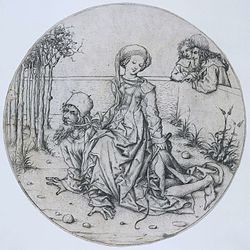
The tale of Phyllis and Aristotle is a medieval cautionary tale about the triumph of a seductive woman, Phyllis, over the greatest male intellect, the ancient Greek philosopher Aristotle. It is one of several Power of Women stories from that time. Among early versions is the French Lai d'Aristote from 1220.
Contents
- Story
- Origins
- Analysis
- Illustrations
- Medieval
- Early Modern to Enlightenment
- Nineteenth and twentieth centuries
- Notes
- References
The story of the dominatrix and the famous intellectual was taken up by artists from the 12th century onwards, in media from stone sculpture in churches to panels of wood or ivory, textiles such as carpets and tapestries, engravings, oil paintings, brass jugs (aquamanile), and stained glass. Artists attracted to the theme include Hans Baldung, Albrecht Dürer, Lucas Cranach the Elder, and Alessandro Turchi.

















